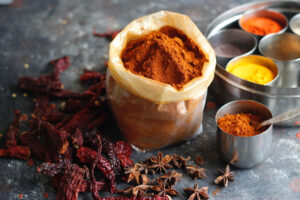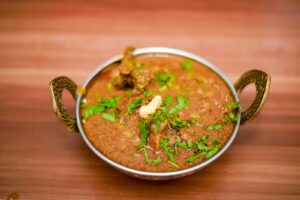A Balti curry is any curry cooked in a Balti dish or bowl, a wok-like cooking pot made from thinly pressed steel.
What does “balti” mean?
The word itself came to English from Hindustani, although it is also found in Odia and Bengali, and means ‘bucket’. It was an adaptation of the Portuguese word balde, which arrived on the Indian subcontinent with Portuguese merchants in the 16th century.
Balti curry origin
The dish is particularly associated with Northern India and Pakistan, and with Birmingham in the United Kingdom.
Indeed, the Birmingham balti, a fusion of Kashmiri dishes created by the city’s Mirpuri community in the 1970s, was even the subject of a long campaign to get protected name status from the EU, before Brexit scuppered the plan. The Birmingham balti tends to be lighter, healthier and faster to cook than those found in India and Pakistan.
Some have said that the Birmingham balti developed as the men who had come over to work in the UK in the 1970s were unable to bring their wives with them, so developed the dish to be prepared quickly at the end of a long day’s work, rather than cooking all day as curries are traditionally made in India and Pakistan.
Baltis were then made lighter and healthier by chefs who began to cater for Western tastes.
What is Balti cooked with?
As the balti is named for the utensil used to cook it, there are no definitive ingredients list associated with it. Traditional curry flavours like tikka masala, tandoori, rogan josh and korma can all be cooked in a balti style.
Nevertheless, there are some features which are common to all baltis. Baltis are cooked stir-fry style with vegetable oil not ghee, over a high heat. Any meat off the bone can be used, with onions, garlic, turmeric, and the spice mix garam masala frequently used to prepare the sauce. The meats most often used in a balti are lamb and chicken, but pork and prawns are also commonplace.
Vegetarian options will often feature mushrooms or paneer, a form of cheese found in the Indian subcontinent.
Is Balti spicy?
Because there are no definitive ingredients, there is no definitive level of spiciness, especially as different forms of curry flavour can be cooked in a balti style. Most standard baltis however are cooked to a medium level of spice, hotter than a korma or a pasanda, but less spicy than a jalfrezi or madras.
Restaurants are usually flexible however, and you can ask them to dial the spice up or down if you prefer, or choose one of the other traditional styles.

How is Balti served?
A proper balti is served in the dish it was cooked in, so be careful when you order one as it will be very hot! The most frequent accompaniment to a balti is either naan or rice. Naan is a pillowy, leavened, oven-baked flatbread, and is perfect for mopping up the last vestiges of balti from the dish. Some people say naan bread, which is an error – naan is itself the Hindi word for bread! Naans can be served cooked with garlic, coriander, cheese, mincemeat, or as a sweetened form called a peshwari naan. Rice is served either plain, cooked as a pilau (rice cooked in the oven with turmeric, and often many other ingredients) or with mushrooms or other additions.

Poppadoms, a thin and crispy treat that is technically a form of flatbread, made from gram or lentil flour and either fried or cooked with a dry heat, are also a common accompaniment to balti. They are sometimes served with the balti, to be dunked in, but most commonly they are used as a starter beforehand, served with raita (a mint yoghurt sauce), chutneys such as mango chutney, raw onion, coriander and other salad items or sauces. Lentil dahls, onion bhajis, pakoras and aloo gobi (a dish made of spiced potatoes and cauliflower) are other common side dishes to a balti.
Where is the Balti triangle?
In Britain, Balti is especially associated with the city of Birmingham.
The Birmingham balti may have first been served in a restaurant called Adil’s in Stoney Lane, in the Sparkbrook region of the City in the late 1970s. Although this is unproven, the area around Sparkbrook, Sparkhill and Moseley is now known as the Balti Triangle and is famous for the number and quality of balti restaurants, called balti houses in Birmingham.
Other areas known for their balti houses are a stretch of the Pershore Road in the Birmingham district of Stirchley, as well as parts of the nearby areas of Cotteridge and Kings Heath and the ‘Balti Mile’ in Lye, near Stourbridge to the west of Birmingham.
Balti houses have spread out from Birmingham to the wider West Midlands and the rest of the UK, as well as many other English-speaking countries, such as Ireland, Australia and New Zealand. Despite this, many people claim it is not possible to get a proper balti curry outside of the urban districts of Birmingham and the Black Country.
